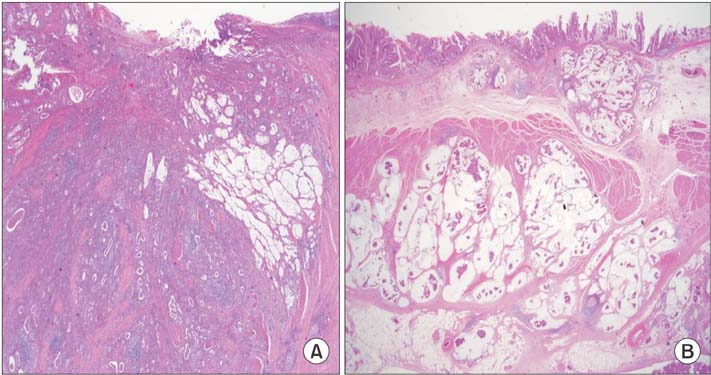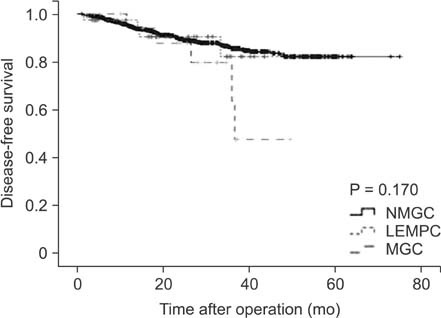Ann Surg Treat Res.
2015 Nov;89(5):254-260. 10.4174/astr.2015.89.5.254.
Effect of extramucin pools in gastric cancer patients
- Affiliations
-
- 1Department of Surgery, Pusan National University Yangsan Hospital, Yangsan, Korea. hwangsh@pusan.ac.kr
- 2Department of Internal Medicine, Pusan National University Yangsan Hospital, Yangsan, Korea.
- 3Department of Surgery, Pusan National University School of Medicine, Busan, Korea.
- KMID: 2095531
- DOI: http://doi.org/10.4174/astr.2015.89.5.254
Abstract
- PURPOSE
Mucinous gastric adenocarcinoma (MGC) is defined by the World Health Organization as a gastric adenocarcinoma with >50% extracellular mucin pools within the tumors. In this study, we attempted to analyze the clinicopathologic features of patients pathologically diagnosed as gastric cancer with lower than 50% tumor volume of extracellular mucin pool adenocarcinoma (LEMPC). We compared MGC versus nonmucinous gastric adenocarcinoma (NMGC). We were used in abbreviations LEMPC for NMGC including extracellular mucin pool.
METHODS
Files of 995 patients with gastric cancer NMGC (n = 935), MGC (n = 20), LEMPC (n = 40) who underwent curative resection at Pusan National University Yangsan Hospital from December 2008 to December 2013 were retrospectively analyzed. All pathologic reports after curative resection and evaluated clinicopathologic features were reviewed to identify the effect of extracellular mucin pools in gastric cancer.
RESULTS
Compared with the NMGC patients, the clinicopathological features of MGC patients were as follows: more frequent open surgery, larger tumor size, more advanced T stage and N stage, more positive lymph node metastasis, and perineural invasion. LEMPC patients showed similar features compared with NMGC patients. MGC and LEMPC patients showed similar clinicopathological features, except T stage and lymph node metastasis.
CONCLUSION
LEMPC can be thought of as a previous step of MGC. It is reasonable to consider LEMPC patients in the diagnostic criteria of MGC, and to adequately treat.
Keyword
MeSH Terms
Figure
Reference
-
1. Bosman FT. World Health Organization. International Agency for Research on Cancer. WHO classification of tumours of the digestive system. 4th ed. Lyon: International Agency for Research on Cancer;2010. (World Health Organization classification of tumours; v. 3).2. Hoerr SO, Hazard JB, Bailey D. Prognosis in carcinoma of the stomach in relation to the microscopic type. Surg Gynecol Obstet. 1966; 122:485–494.3. Adachi Y, Mori M, Kido A, Shimono R, Maehara Y, Sugimachi K. A clinicopathologic study of mucinous gastric carcinoma. Cancer. 1992; 69:866–871.4. Brander WL, Needham PR, Morgan AD. Indolent mucoid carcinoma of stomach. J Clin Pathol. 1974; 27:536–541.5. Epstein J, Lieberman PH. Mucinous adenocarcinoma of the prostate gland. Am J Surg Pathol. 1985; 9:299–308.6. Kawamura H, Kondo Y, Osawa S, Nisida Y, Okada K, Isizu H, et al. A clinicopathologic study of mucinous adenocarcinoma of the stomach. Gastric Cancer. 2001; 4:83–86.7. Lim SW, Kim DY, Kim YJ, Kim SK. Clinicopathologic features of mucinous gastric carcinoma. Dig Surg. 2002; 19:286–290.8. Kunisaki C, Akiyama H, Nomura M, Matsuda G, Otsuka Y, Ono HA, et al. Clinicopathologic characteristics and surgical outcomes of mucinous gastric carcinoma. Ann Surg Oncol. 2006; 13:836–842.9. Hyung WJ, Noh SH, Shin DW, Yoo CH, Kim CB, Min JS, et al. Clinicopathologic characteristics of mucinous gastric adenocarcinoma. Yonsei Med J. 1999; 40:99–106.10. Sano T, Aiko T. New Japanese classifications and treatment guidelines for gastric cancer: revision concepts and major revised points. Gastric Cancer. 2011; 14:97–100.11. Sassa H, Kino I. A comparative study on mucinous carcinoma of the stomach and large intestine. II. Mucin histochemical study (author's transl). Nihon Shokakibyo Gakkai Zasshi. 1979; 76:861–870.12. Hidaka S, Tanaka K, Takeshita H, Sumida Y, Fukuoka H, Abo T, et al. Clinicopathology and prognosis of mucinous gastric carcinoma. Hepatogastroenterology. 2008; 55:791–794.13. Zhang M, Zhu GY, Zhang HF, Gao HY, Han XF, Xue YW. Clinicopathologic characteristics and prognosis of mucinous gastric carcinoma. J Surg Oncol. 2010; 102:64–67.14. Koufuji K, Takeda J, Toyonaga A, Kodama I, Aoyagi K, Yano S, et al. Mucinous adenocarcinoma of the stomach-clinicopathological studies. Kurume Med J. 1996; 43:289–294.15. Kufe DW. Mucins in cancer: function, prognosis and therapy. Nat Rev Cancer. 2009; 9:874–885.16. Kim DH, Kim SM, Hyun JK, Choi MG, Noh JH, Sohn TS, et al. Changes in postoperative recurrence and prognostic risk factors for patients with gastric cancer who underwent curative gastric resection during different time periods. Ann Surg Oncol. 2013; 20:2317–2327.17. Lo SS, Wu CW, Chen JH, Li AF, Hsieh MC, Shen KH, et al. Surgical results of early gastric cancer and proposing a treatment strategy. Ann Surg Oncol. 2007; 14:340–347.18. Shiraishi N, Sato K, Yasuda K, Inomata M, Kitano S. Multivariate prognostic study on large gastric cancer. J Surg Oncol. 2007; 96:14–18.




